Music
Trailers
DailyVideos
India
Pakistan
Afghanistan
Bangladesh
Srilanka
Nepal
Thailand
Iraq
Iran
Russia
Brazil
StockMarket
Business
CryptoCurrency
Technology
Startup
Trending Videos
Coupons
Football
Search
Download App in Playstore
Download App
Best Collections
Technology
Yesterday, Samsung announced that the Galaxy Flip Z sold out online. What, precisely, that means, is hard to say, of course, without specific numbers from the company. But itprobably enough to make the company bullish about its latest wade into the foldable waters, in the wake of last yearFold — letjust say &troubles.&
Response to the device has been positive. I wrote mostly nice things about the Flip, with the caveat that the company only loaned out the product for 24 hours (I won&t complain here about heading into the city on a Saturday in 20-degree weather to return the device. I&m mostly not that petty).
Heck, the product even scored a (slightly) better score on iFixitrepairability meter than the Razr. Keep in mind, it got a 2/10 to Motorola1/10 (the lowest score), but in 2020, we&re all taking victories where we can get them.
Therebeen some negative coverage mixed in, as well, of course; iFixit noted that the Flip could have some potential long-term dusty problems due to its hinge, writing, &it seems like dust might be this phoneKryptonite.& Also, the $1,400 phonenew, improved folding glass has proven to be vulnerable to fingernails, of all things — a definite downside if you have, you know, fingers.
Reports of cracked screens have also begun to surface, owing, perhaps, to cold weather. Itstill hard to say how widespread these concerns are. Samsungsaving grace, however, could well be the Razr. First the device made it through a fraction of the folds of Samsungfirst-gen product. Then reviewers and users alike complained of a noisy fold mechanism and build quality that might be…lacking.
A review at Input had some major issues with a screen that appeared to fall apart at the seams (again, perhaps due to cold weather). Motorola went on the defensive, issuing the following statement:
We have full confidence in razrdisplay, and do not expect consumers to experience display peeling as a result of normal use. As part of its development process, razr underwent extreme temperature testing. As with any mobile phone, Motorola recommends not storing (e.g., in a car) your phone in temperatures below -4 degrees Fahrenheit and above 140 degrees Fahrenheit. If consumers experience device failure related to weather during normal use, and not as a result of abuse or misuse, it will be covered under our standard warranty.
Consensus among reviews is to wait. The Flip is certainly a strong indication that the category is heading in the right direction. And Samsung is licensing its folding glass technology, which should help competitors get a bit of a jump start and hopefully avoid some of the pitfalls of the first-gen Fold and Razr.
A new survey from PCMag shows that 82% of consumers don&t plan to purchase such a device, with things like snapping hinges, fragile screens and creases populating the list of concerns. Which, honestly, fair enough on all accounts.
The rush to get to market has surely done the category a disservice. Those who consider themselves early adopters are exactly the people who regularly read tech reviews, and widespread issues are likely enough to make many reconsider pulling the trigger on a $1,500-$2,000 device. Even early adopters are thrilled about the idea of beta testing for that much money.
Two steps forward, one step back, perhaps? Letcheck back in a generation or two from now and talk.
- Details
- Category: Technology Today
Read more: One year later, the future of foldables remains uncertain
Write comment (98 Comments)Quibi, the mobile-only streaming service from Jeffrey Katzenberg, is now open for pre-orders. The company declined to fully show off its app only a month ago during demos of its &TurnStyle& technology at the Consumer Electronics Show in Las Vegas, but it appears the app is ready nonetheless. Quibi is listed on both AppleApp Store and Google Play, where itbeen given a pre-order date of April 6, 2020 — the date Quibinew service goes live.
The app was actually published to the app stores in January, according to data from Sensor Tower and App Annie. Quibi confirmed the app actually opened up for pre-orders on January 30, but this hadn&t been reported yet by media. (Chrissy Teigen tweeted it, however.)

Apple first introduced pre-order functionality for apps and games in late 2017, allowing interested consumers to have a new app or game automatically download to their device on launch day. And in the case of paid apps, customers aren&t charged until the app becomes available.
Since launch, the pre-order system has largely been used with mobile games. Apple even devotes part of its iOS App Store to a &Coming Soon& section where you can find upcoming games for pre-order.
Itfar less common for non-games to utilize a pre-order system. By doing so, ita signal that the company plans to do a significant marketing push ahead of the apprelease, likely in hopes of achieving a higher number of day-one downloads than it would otherwise.
Thatimportant in Quibicase, given the competition that awaits it. Disney+, for example, blew past expectations to reach nearly 29 million subscribersin less than 3 months after its U.S. debut. Quibi, meanwhile, will arrive in the spring, just ahead of when WarnerMediaHBO Max and NBCUPeacock also begin rolling out. Quibi can&t wait until the market is even more crowded to start pushing users to download its app — it needs to capture users& attention now.

With Quibiapp store listings now live, we also have our first glimpse of the streaming serviceuser interface.
Much has been made about Quibipotential to reimagine TV by taking advantage of mobile technology in new ways, but the app itself looks much like any other streaming service, save for its last app store screenshot showing off its TurnStyle technology.
The app appears to favor a dark theme common to streaming apps, like Netflix and Prime Video, with just four main navigation buttons at the bottom.
The first is a personalized For You page, where you&re presented a feed where you&ll discover new things Quibi thinks you&ll like.
A Search tab will point you toward trending shows and it will allow you to search by show titles, genre or even mood.
The Following tab helps you keep track of your favorite shows and a Downloads tab keeps track of those you&ve made available for offline viewing.
Otherwise, Quibiinterface is fairly simple. Shows are displayed with big images that you flip through either vertically on your home feed or both horizontally and vertically as you move through the Browse section.
The company does promote its TurnStyle viewing technology in its app store description, though it doesn&t reference the technology by name. Instead, it describes it as a viewing experience that puts you in full control. &No matter how you hold your phone, everything is framed to fit your screen,& it says.
In vertical viewing mode, it also introduces controls that appear on either the left or right side the screen — you choose, based on whether you&re left or right-handed.
Quibi did not formally announce the app was open for pre-order.
The startup, founded by Jeffrey Katzenberg, is backed by more than a billion dollars — including a recently closed $400 million round.
Katzenberg explained at CES that every great innovation in Hollywood has been driven by new technology, but todaystreaming services haven&t fully capitalized on the way many people consume content — meaning, on their phone. Quibi plans to make its service mobile-first, with TurnStyle for better viewing. And later, by using the phoneother sensors and features to create different types of stories, like a horror show you can only watch at night or interactive fitness programs that can track your steps, among other things.
But Quibi could easily come across as gimmicky if it doesn&t get the experience right with quality content, too. Even if Quibi doesn&t pan out as a standalone streamer, it could license its TurnStyle tech to others in the streaming space — that would make Quibi one of the most expensive demo apps of all time.
Updated 2/20/20, 6 PM ET to clarify the app was opened to pre-orders on Jan 30, according to Quibi, but it wasn&t publicly announced. Sensor Tower had earlier said the app was only made available for pre-order today. The app was updated today, however.
- Details
- Category: Technology Today
Read more: Quibi’s streaming service app launches in app stores for pre-order
Write comment (99 Comments)March 2 is the planned launch date for SpaceX 20th ISS resupply mission, which is bringing the usual supplies and goodies, plus a payload of interesting experiments from partners and paying customers. And a big expansion to EuropeColumbus Module.
The most ridiculous has to be Adidas&BOOST in Space& effort. The company creates its midsoles by fusing together thousands of tiny foam spheres. But sadly, this is generally done on Earth, where theregravity. So of course they want to try it in space to see what they can learn.
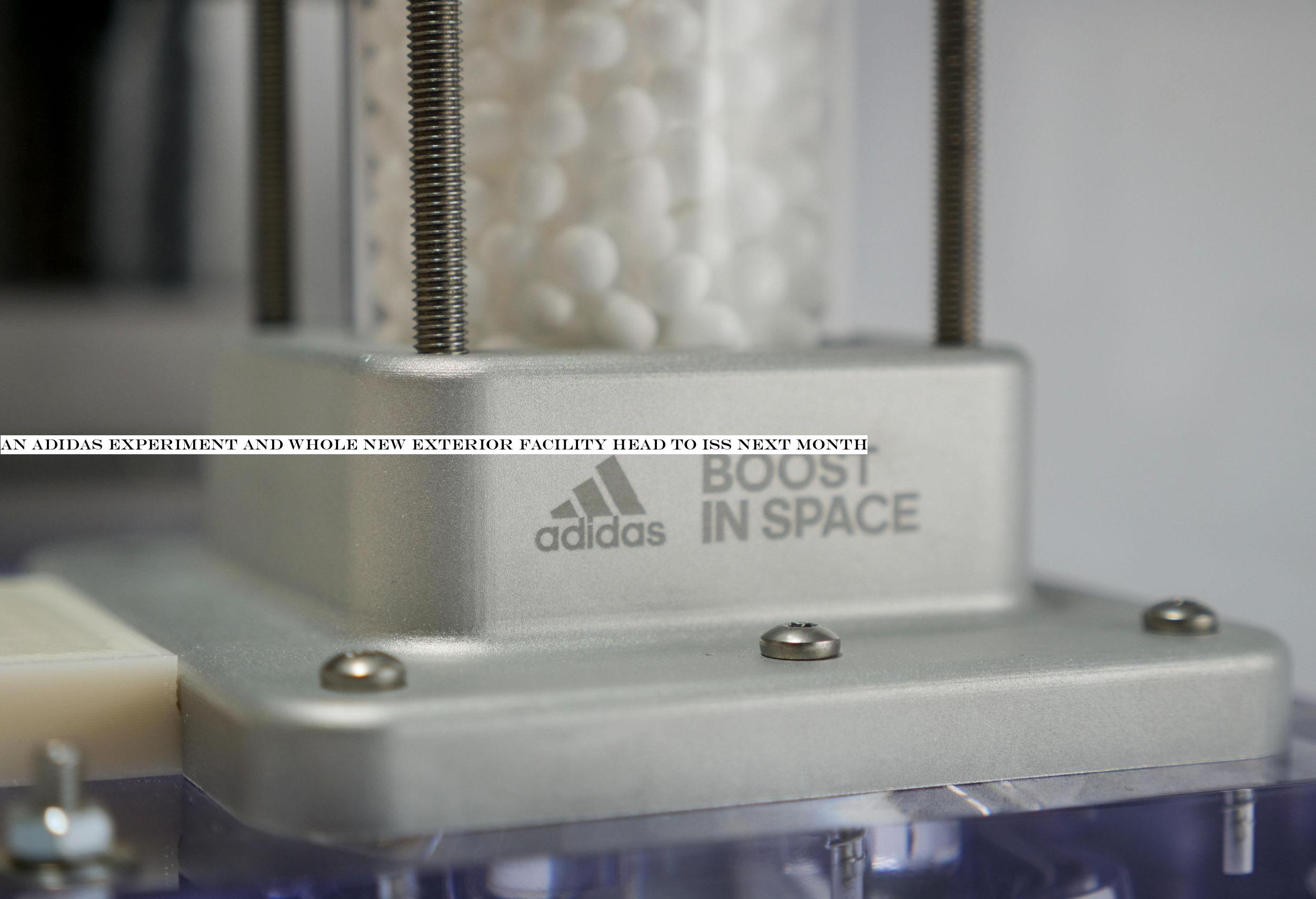
&Microgravity enables a closer look at the factors behind pellet motion and location, which could enhance manufacturing processes as well as product performance and comfort,& the project description reads. It also makes for a great stunt. The revelations from this toaster-sized device will surely lead to better shoes.
Itfunny, but as always with these commercial operations, itpretty cool that itpossible to just decide to do some experimenting in the ISS.
Microgravity is a sought-after condition, and several of the other research projects going up rely on it as well. Another commercial operation is from Delta, the faucet maker, which thinks it might be able to learn something about droplet formation and create more efficient showers and such.

Gut tissue isn&t normally this blue, but thatnot an effect of microgravity.
Emulate is sending up an organ-on-a-chip, intestinal tissue to be precise, which it hopes will help teach us &how microgravity and other potential space travel stressors affect intestine immune cells and susceptibility to infection.& They&re also testing the growth of heart tissue from stem cells up there, which could come in handy on long voyages.
The biggest payload, though, has to be Bartolomeo, a new exterior platform that will attach to the European Columbus Module:
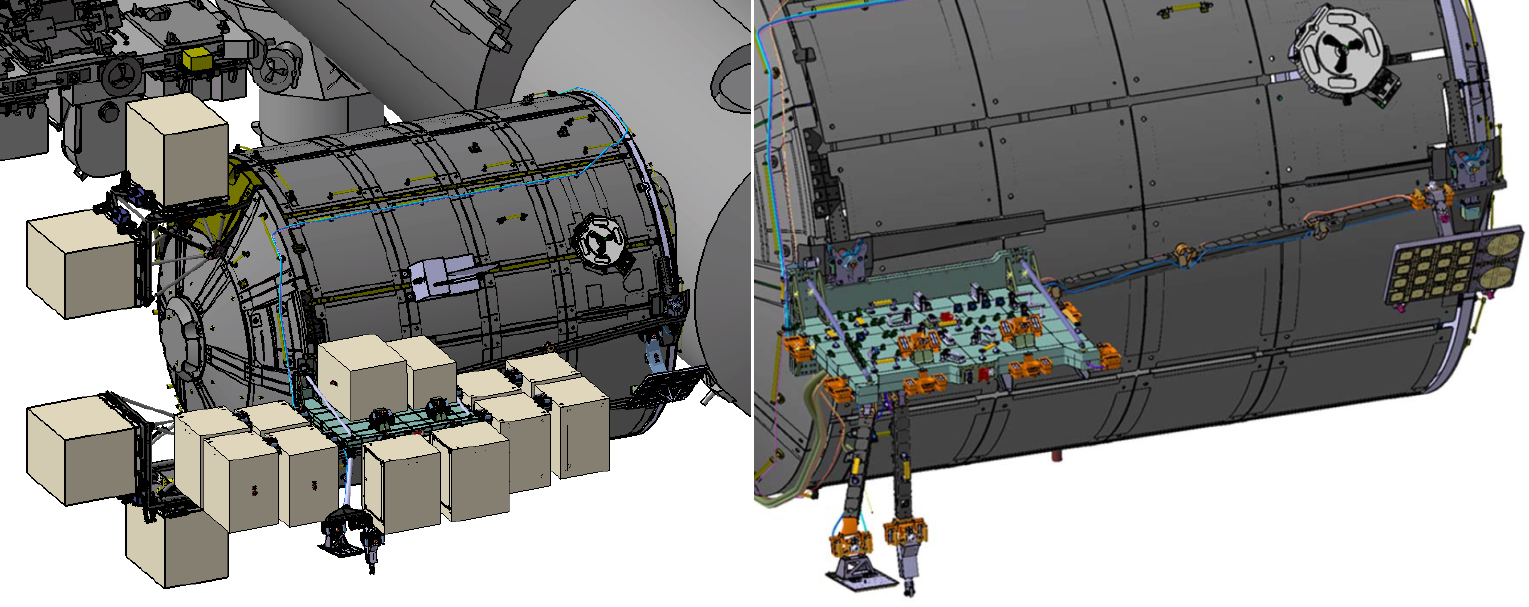
With payloads attached, left, and without, right. Therea boom that sticks out for other purposes.
It has 12 sites onto which can be attached payloads from commercial and institutional partners — anyone from universities to companies that need access to the exterior of the space station for one reason or another. Earth imagery, vacuum exposure, radiation testing, whatever you like. You can read about the specifications here.
The launch is set for March 2 if all goes well — we&ll post the live stream and any other updates closer to T-0.
- Details
- Category: Technology Today
Read more: An Adidas experiment and whole new exterior facility head to ISS next month
Write comment (91 Comments)Amazon may have a market cap of more than $1 trillion, but Finbarr Taylor, CEO of Y Combinator-backed startupShogun, said the e-commerce giant is &kind of dropping the ball.&
Specifically, he argued that the experience of shopping on Amazon — not what happens after you buy something, but browsing the website itself — is pretty bad, full of sponsored results and fake products.
&What we&re seeing happen is that all this vast wave of direct-to-consumer brands is nibbling around edges of Amazon and beating them on buying experience,& Taylor said.
Shogun was designed to support those brands. Taylor and his co-founder Nick Raushenbush created the first product in 2015, and they treated it as a side project at first. But Taylor said that by May 2017, &It ate up all of our free time and it was obviously much bigger than we expected,& so they quit their jobs (Taylor was working as a software engineer at Y Combinator) and devoted themselves to it full-time.
The company now has 11,000 customers, including MVMT, K-Swiss and Leesa. And today, Shogun is announcing that it has raised a $10 million Series A, led by Initialized Capital, with participation from VMG Partners and YC. (The startup has now raised a total of $12 million.)
The companyfirst product, Page Builder, offers a drag-and-drop interface to make it easier for e-commerce brands to build their storefronts on Shopify, BigCommerce, Salesforce and Magento.
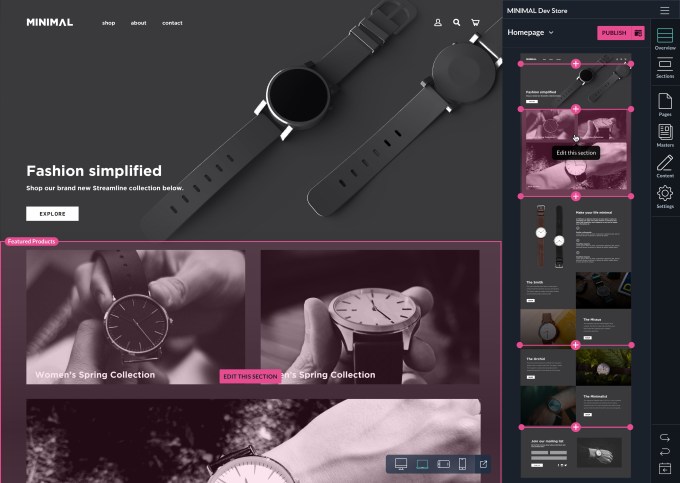
And therea new product,Shogun Frontend, which allows brands to create a web storefront thatentirely customized while still using one of the big commerce platforms as their back end.
Taylor pitched this as part of a broader trend toward &headless commerce,& where the e-commerce front end and back end are handled separately. He suggested that this is a &mutually beneficial& split, as Shopify and its competitors are going &super deep& on building the infrastructure needed to operate a store online, while Shogun focuses on the actual experience of the customer visiting that store.
Meanwhile, website builders like Squarespace and Weebly (owned by Square) have introduced e-commerce features, but Taylor suggested that they&re still ¬ really a professional choice& for most e-commerce businesses.
As one of the key features of Shogun Frontend, Taylor pointed to the fact that it creates progressive web apps that should be as fast and smooth as a native app.
Brett Gibson, general partner at Initialized Capital and a Shogun board member, made a similar point in a statement:
For DTC brands competing against goliaths like Amazon, Shogun Frontend now gives them features and capabilities once only reserved for enterprise companies. And when it comes to speed, Shogun Frontendsub-second load time is the critical difference between retaining or losing a customer.
Taylor added that the company will be &continuing to invest in Page Builder too,& but he suggested that Frontend is &more of an enterprise offering& that can help Shogunbiggest customers &future proof themselves.&
- Details
- Category: Technology Today
Read more: Shogun raises $10M to help e-commerce brands build faster websites
Write comment (99 Comments)
During the days when Snapchatpopularity was booming, investors thought the company would become the anchor for a new Los Angeles technology scene.
Snapchat, they hoped, would spin-off entrepreneurs and angel investors who would reinvest in the local ecosystem and create new companies that would in turn foster more wealth, establishing LA as a hub for tech talent and venture dollars on par with New York and Boston.
In the ensuing years, Los Angeles and its entrepreneurial talent pool has captured more attention from local and national investors, but itnot Snap thatbeen the source for the next generation of local founders. Instead, several former SpaceX employees have launched a raft of new companies, capturing the imagination and dollars of some of the biggest names in venture capital.
&There was a buzz, but it doesn&t quite have the depth of bench of people that investors wanted it to become,& says one longtime VC based in the City of Angels. &It was a company in LA more than it was an LA company.&
Perhaps the most successful SpaceX offshoot is Relativity Space, founded by Jordan Noone and Tim Ellis. Since Noone, a former SpaceX engineer, and Ellis, a former Blue Origin engineer, founded their company, the business has been (forgive the expression) a rocket ship. Over the past four years, Relativity href="https://techcrunch.com/2019/10/01/relativity-a-new-star-in-the-space-race-raises-160-million-for-its-3-d-printed-rockets/"> has raised $185.7 million, received special dispensations from NASA to test its rockets at a facility in Alabama, will launch vehicles from Cape Canaveral and has signed up an early customer in Momentus, which provides satellite tug services in orbit.
- Details
- Category: Technology Today
Read more: SpaceX alumni are helping build LA’s startup ecosystem
Write comment (99 Comments)&The Mandalorian& was a pretty good show. On that most people seem to agree. But while a successful live-action Star Wars TV series is important in its own right, the way this particular show was made represents a far greater change, perhaps the most important since the green screen. The cutting edge tech (literally) behind &The Mandalorian& creates a new standard and paradigm for media — and the audience will be none the wiser.
What is this magical new technology? Itan evolution of a technique thatbeen in use for nearly a century in one form or another: displaying a live image behind the actors. The advance is not in the idea but the execution: a confluence of technologies that redefines &virtual production& and will empower a new generation of creators.
As detailed in an extensive report in American Cinematographer Magazine (I&ve been chasing this story for some time, but suspected this venerable trade publication would get the drop on me), the production process of &The Mandalorian& is completely unlike any before, and ithard to imagine any major film production not using the technology going forward.
&So what the hell is it?& I hear you asking.
Meet &the Volume.&
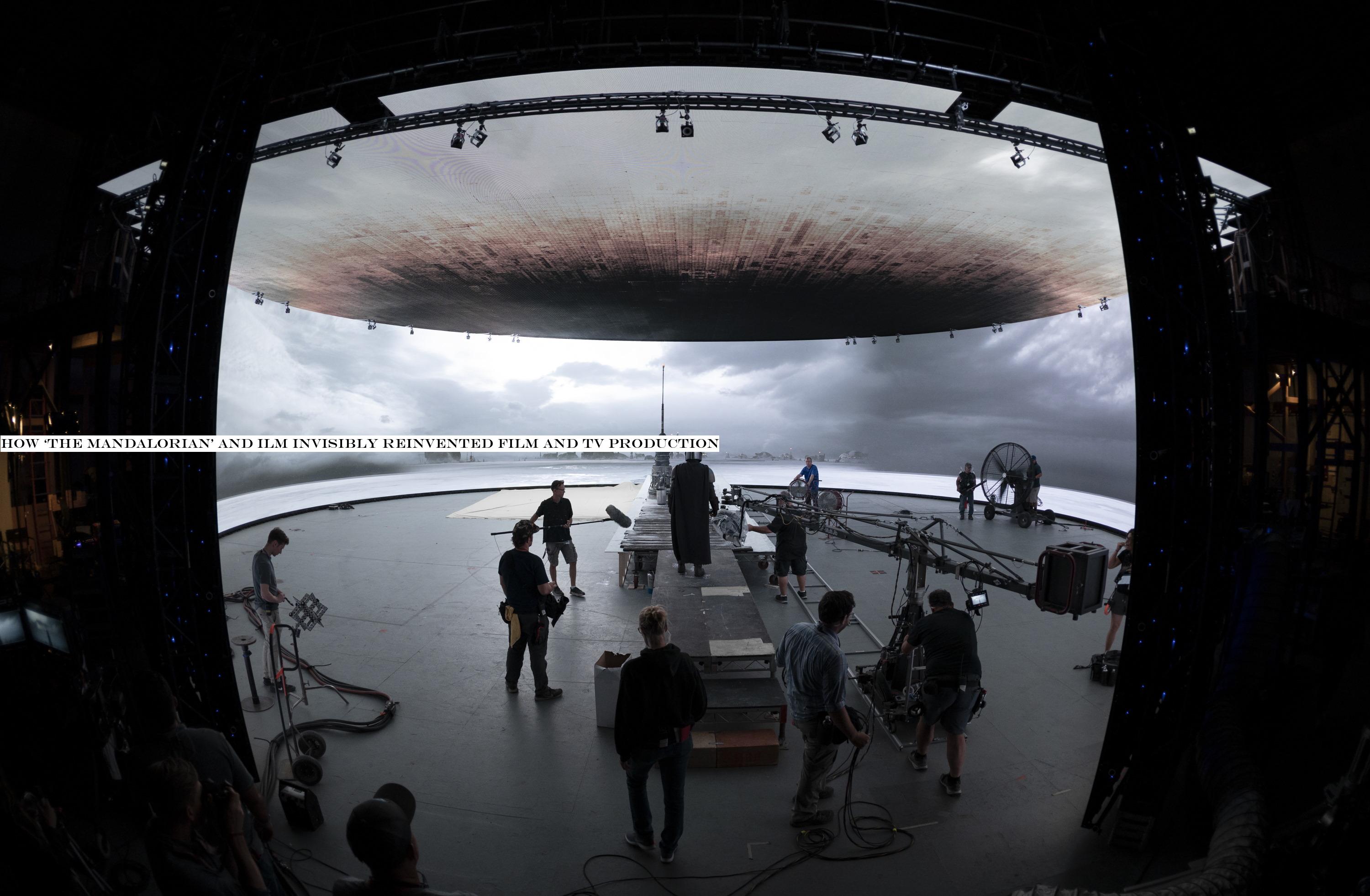
Formally called Stagecraft, it20 feet tall, 270 degrees around, and 75 feet across — the largest and most sophisticated virtual filmmaking environment yet made. ILM just today publicly released a behind-the-scenes video of the system in use, as well as a number of new details about it.
Itnot easy being green
In filmmaking terms, a &volume& generally refers to a space where motion capture and compositing take place. Some volumes are big and built into sets, as you might have seen in behind-the-scenes footage of Marvel or Star Wars movies. Some are smaller, plainer affairs, where the motions of the actors behind CG characters play out their roles.
But they generally have one thing in common: They&re static. Giant, bright green, blank expanses.
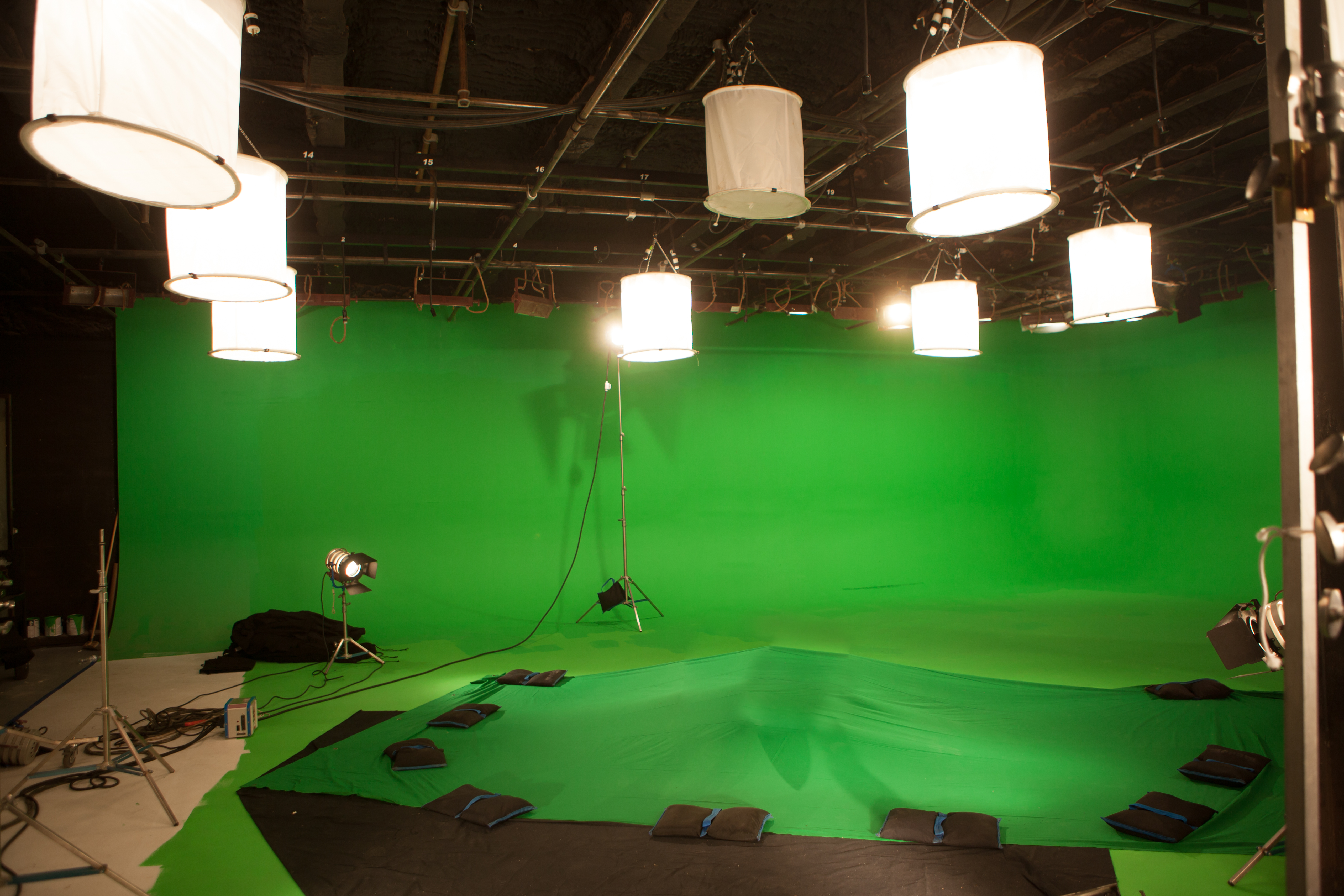
Does that look like fun to shoot in?
One of the most difficult things for an actor in modern filmmaking is getting into character while surrounded by green walls, foam blocks indicating obstacles to be painted in later and people with mocap dots on their face and suits with ping-pong balls attached. Not to mention everything has green reflections that need to be lit or colored out.
Advances some time ago (think prequels-era Star Wars) enabled cameras to display a rough pre-visualization of what the final film would look like, instantly substituting CG backgrounds and characters onto monitors. Sure, that helps with composition and camera movement, but the world of the film isn&t there, the way it is with practical sets and on-site shoots.
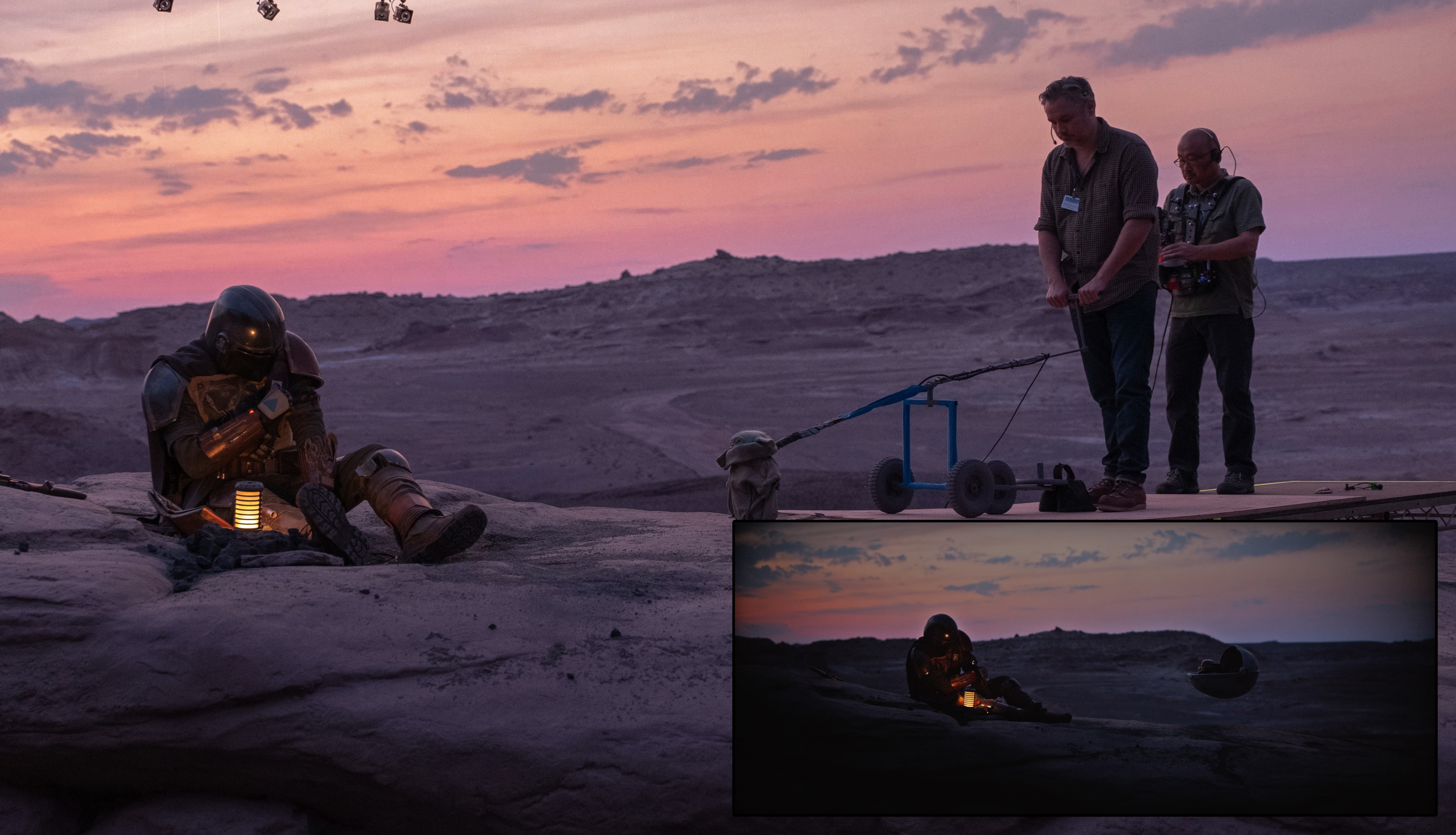
Practical effects were a deliberate choice for &The Child& (AKA Baby Yoda) as well.
Whatmore, because of the limitations in rendering CG content, the movements of the camera are often restricted to a dolly track or a few pre-selected shots for which the content (and lighting, as we&ll see) has been prepared.
This particular volume, called Stagecraft by ILM, the company that put it together, is not static. The background is a set of enormous LED screens such as you might have seen onstage at conferences and concerts. The Stagecraft volume is bigger than any of those — but more importantly, itsmarter.
See, itnot enough to just show an image behind the actors. Filmmakers have been doing that with projected backgrounds since the silent era! And thatfine if you just want to have a fake view out of a studio window or fake a location behind a static shot. The problem arises when you want to do anything more fancy than that, like move the camera. Because when the camera moves, it immediately becomes clear that the background is a flat image.
The innovation in Stagecraft and other, smaller LED walls (the more general term for these backgrounds) is not only that the image shown is generated live in photorealistic 3D by powerful GPUs, but that 3D scene is directly affected by the movements and settings of the camera. If the camera moves to the right, the image alters just as if it were a real scene.

This is remarkably hard to achieve. In order for it to work, the camera must send its real-time position and orientation to, essentially, a beast of a gaming PC, because this and other setups like it generally run on the Unreal engine (Epic does its own breakdown of the process here). This must take that movement and render it exactly in the 3D environment, with attendant changes to perspective, lighting, distortion, depth of field and so on — all fast enough so that those changes can be shown on the giant wall nearly instantly. After all, if the movement of the background lagged the camera by more than a handful frames it would be noticeable to even the most naive viewer.
Yet fully half of the scenes in &The Mandalorian& were shot within Stagecraft, and my guess is no one had any idea. Interior, exterior, alien worlds or spaceship cockpits, all used this giant volume for one purpose or another.
[gallery ids="1949115,1949123,1949122,1949124"]
There are innumerable technological advances that have contributed to this; &The Mandalorian& could not have been made as it was five years ago. The walls weren&t ready; the rendering tech wasn&t ready; the tracking wasn&t ready — nothing was ready. But itready now.
It must be mentioned that Jon Favreau has been a driving force behind this filmmaking method for years now; films like the remake of &The Lion King& were in some ways tech tryouts for &The Mandalorian.& Combined with advances made by James Cameron in virtual filmmaking, and, of course, the indefatigable Andy Serkiswork in motion capture, this kind of production is only just now becoming realistic due to a confluence of circumstances.
Not just for SFX
Of course Stagecraft is probably also the most expensive and complex production environments ever used. But what it adds in technological overhead (and therea lot) it more than pays back in all kinds of benefits.
For one thing, it nearly eliminates on-location shooting, which is phenomenally expensive and time-consuming. Instead of going to Tunisia to get those wide-open desert shots, you can build a sandy set and put a photorealistic desert behind the actors. You can even combine these ideas for the best of both worlds: Send a team to scout locations in Tunisia and capture them in high-definition 3D to be used as a virtual background.
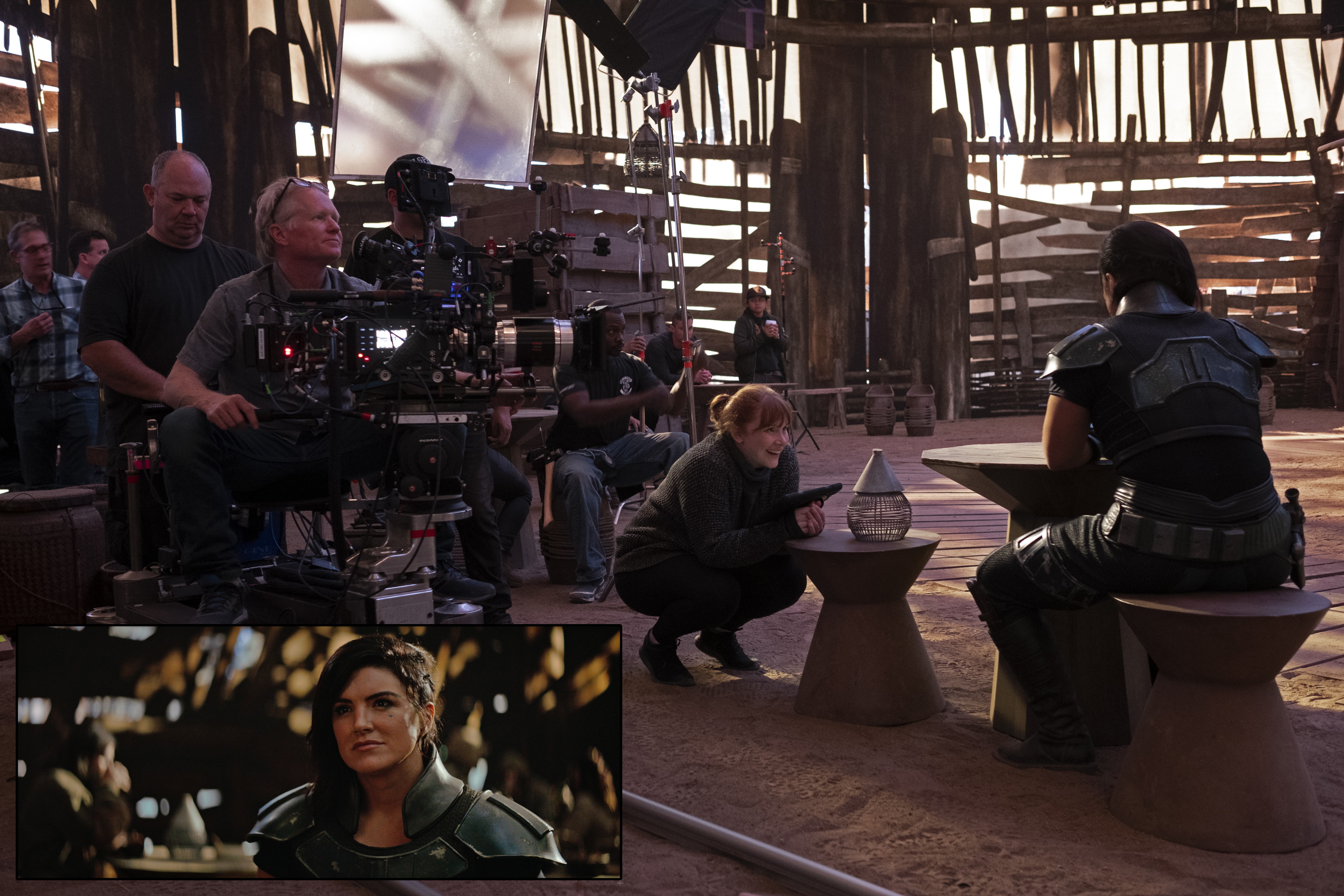
This last option produces an amazing secondary benefit: Reshoots are way easier. If you filmed at a bar in Santa Monica and changes to the dialogue mean you have to shoot the scene over again, no need to wrangle permits and painstakingly light the bar again. Instead, the first time you&re there, you carefully capture the whole scene with the exact lighting and props you had there the first time and use that as a virtual background for the reshoots.
The fact that many effects and backgrounds can be rendered ahead of time and shot in-camera rather than composited in later saves a lot of time and money. It also streamlines the creative process, with decisions able to be made on the spot by the filmmakers and actors, since the volume is reactive to their needs, not vice versa.
Lighting is another thing that is vastly simplified, in some ways at least, by something like Stagecraft. The bright LED wall can provide a ton of illumination, and because it actually represents the scene, that illumination is accurate to the needs of that scene. A red-lit interior of a space station, and the usual falling sparks and so on, shows red on the faces and of course the highly reflective helmet of the Mandalorian himself. Yet the team can also tweak it, for instance sticking a bright white line high on the LED wall out of sight of the camera but which creates a pleasing highlight on the helmet.
Naturally there are some trade-offs. At 20 feet tall, the volume is large but not so large that wide shots won&t capture the top of it, above which you&d see cameras and a different type of LED (the ceiling is also a display, though not as powerful). This necessitates some rotoscoping and post-production, or limits the angles and lenses one can shoot with — but thattrue of any soundstage or volume.
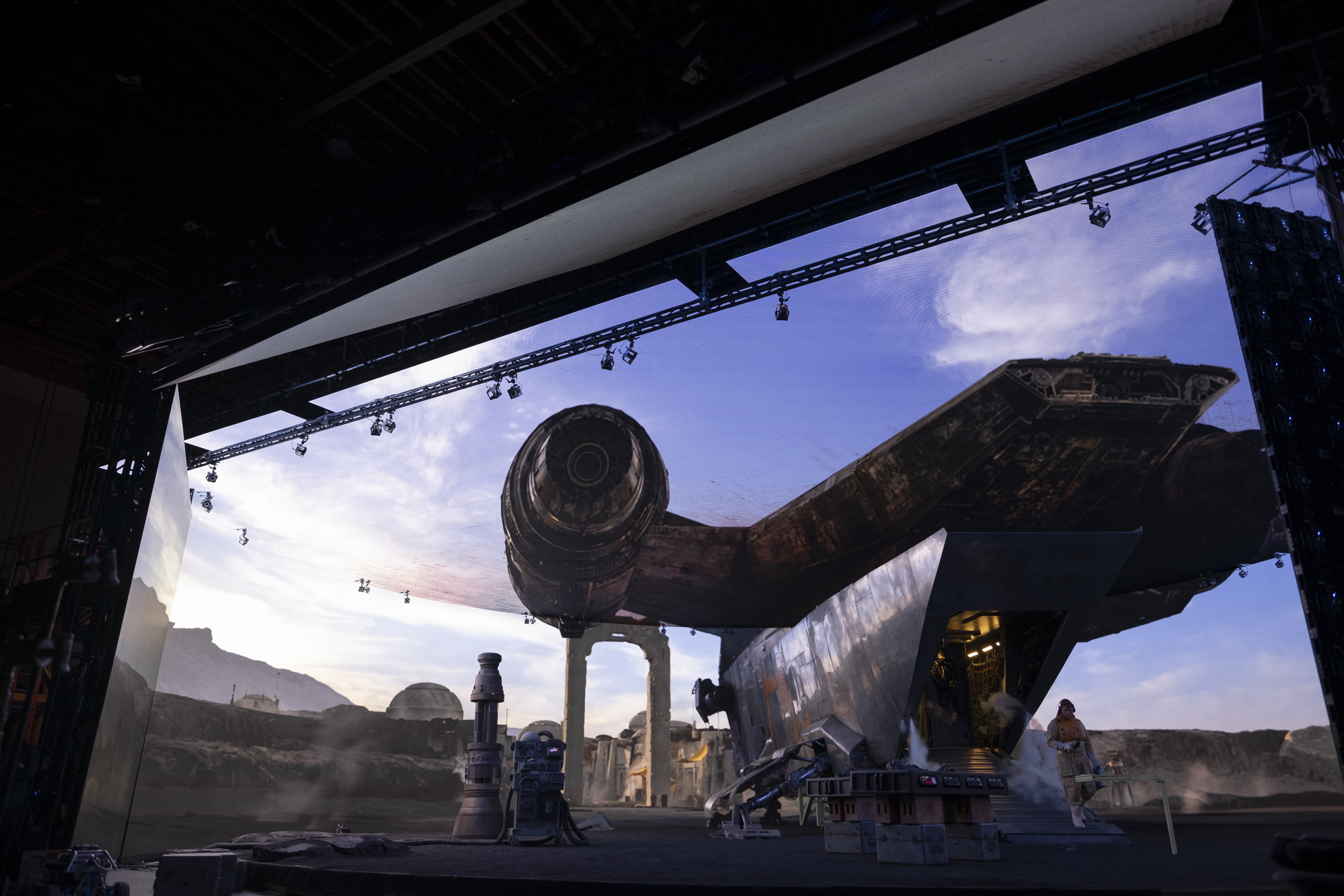
A shot like this would need a little massaging in post, obviously.
The size of the LEDs, that is of the pixels themselves, also limits how close the camera can get to them, and of course you can&t zoom in on an object for closer inspection. If you&re not careful, you&ll end up with Moiré patterns, those stripes you often see on images of screens.
Stagecraft is not the first application of LED walls — they&ve been used for years at smaller scales — but it is certainly by far the most high-profile, and &The Mandalorian& is the first real demonstration of whatpossible using this technology. And believe me, itnot a one-off.
I&ve been told that nearly every production house is building or experimenting with LED walls of various sizes and types — the benefits are that obvious. TV productions can save money but look just as good. Movies can be shot on more flexible schedules. Actors who hate working in front of green screens may find this more palatable. And you better believe commercials are going to find a way to use these as well.
In short, a few years from now itgoing to be uncommon to find a production that doesn&t use an LED wall in some form or another. This is the new standard.
This is only a general overview of the technology that ILM, Disney and their many partners and suppliers are working on. In a follow-up article I&ll be sharing more detailed technical information directly from the production team and technologists who created Stagecraft and its attendant systems.
- Details
- Category: Technology Today
Read more: How ‘The Mandalorian’ and ILM invisibly reinvented film and TV production
Write comment (98 Comments)Page 1435 of 1437

 7
7





